Papers by Abdul Gabbar Al Sharafi
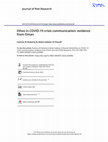
Journal of Risk Research, 2023
There is little research on the effectiveness of the rhetorical strategies adopted by governments... more There is little research on the effectiveness of the rhetorical strategies adopted by governments in COVID-19 crisis communication. This study aimed to answer the following two questions: (1) What are the ethos-related rhetorical strategies used in the official Arabic discourse of COVID-19 crisis communication in Oman? (2) Aligned with Seeger's model of best practice in crisis communication, to what extent are these ethos-related rhetorical strategies effective in delivering a successful crisis response communication? The data came from Oman's COVID-19 Supreme Committee press conference. The data included the first six press conferences covering the period from April 2, 2020 to May 7, 2020. The study showed that Oman's COVID-19 crisis communication exhibits a variety of ethos-related rhetorical strategies, mainly to establish, reinforce and restore speaker's credibility. The study also showed that Oman's COVID-19 crisis communication was effective from a rhetorical perspective because it made use of rhetorical strategies that aligned well with Seeger's best practice of honesty, candor and openness. One of the key recommendations of this paper is to call for Seeger's model to be expanded to cover areas that this model does not currently address, namely speaker's competence and message believability.
Language as a Social Determinant of Health, 2022
Palgrave Studies in Translating and Interpreting, 2022
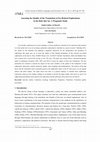
Very broadly, euphemisms are sweet-sounding, or at least inoffensive, alternatives for expression... more Very broadly, euphemisms are sweet-sounding, or at least inoffensive, alternatives for expressions that speakers or writers prefer not to use in executing a particular communicative intention on a given occasion” (Burridge 2012, 66). Based on this definition and adopting a pragmatic framework for the interpretation and translation of euphemism, this paper goes on to assess the quality of four English translations of four selected sex-related euphemisms in the Qur’an. Ross, RABIIT (Royal AAL AL-BAYT Institute Translation), Ghali and Bakhtiar have been selected from a period that extends to over 350 years. The paper uses Juliane House’s functional-pragmatic model of translation evaluation (1981, 2001, and 2015) to assess the quality of these four translations. The four translations are selected to examine the impact of four main variables on the quality of the translation of such euphemistic expressions; namely, historicity, gender, native language and institutionalism. The analysis o...

Babel. Revue internationale de la traduction / International Journal of Translation
One of the contentious issues in religious translation since the legendary St. Jerome is the degr... more One of the contentious issues in religious translation since the legendary St. Jerome is the degree of the translator’s agency. The point of contention has been whether the translator can exercise agency and freedom in translating sacred texts or they should strictly adhere to the form and attend to what St. Jerome called the “mysterious syntax” of the sacred text. Using a stylistic approach (Abdul-Raof 2001 and 2006; Abdel Haleem 1992), we address the issue of the translator’s agency in religious translation by examining the translations of a unique rhetorical feature, namely the verb-noun alternation, by seven key translators in Verses 59, 64, 69 and 72 of Chapter 56, Al-Wāqi‘ah. Despite the general assumption that religious translation is highly constrained and that the translators of this type of text have little freedom, the findings of this paper show that religious translators, in fact, do exercise agency in their translation, whether in the form of adapting the source text t...
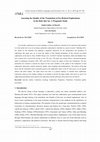
Very broadly, euphemisms are sweet-sounding, or at least inoffensive, alternatives for expression... more Very broadly, euphemisms are sweet-sounding, or at least inoffensive, alternatives for expressions that speakers or writers prefer not to use in executing a particular communicative intention on a given occasion” (Burridge 2012, 66). Based on this definition and adopting a pragmatic framework for the interpretation and translation of euphemism, this paper goes on to assess the quality of four English translations of four selected sex-related euphemisms in the Qur’an. Ross, RABIIT (Royal AAL AL-BAYT Institute Translation), Ghali and Bakhtiar have been selected from a period that extends to over 350 years. The paper uses Juliane House’s functional-pragmatic model of translation evaluation (1981, 2001, and 2015) to assess the quality of these four translations. The four translations are selected to examine the impact of four main variables on the quality of the translation of such euphemistic expressions; namely, historicity, gender, native language and institutionalism. The analysis o...
Use policy The full-text may be used and/or reproduced, and given to third parties in any format ... more Use policy The full-text may be used and/or reproduced, and given to third parties in any format or medium, without prior permission or charge, for personal research or study, educational, or not-for-profit purposes provided that: • a full bibliographic reference is made to the original source • a link is made to the metadata record in Durham E-Theses • the full-text is not changed in any way The full-text must not be sold in any format or medium without the formal permission of the copyright holders. Please consult the full Durham E-Theses policy for further details.
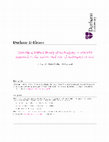
This thesis argues that the scope of metonymy throughout history remains severely reduced to a pr... more This thesis argues that the scope of metonymy throughout history remains severely reduced to a process of word substitution and the signifying potential of the trope is limited to lexical representation. The study therefore proposes a semiotic approach to take the trope beyond this limitation and to develop a textual theory to the trope. A background study related to how metonymy is treated in previous studies is therefore necessary. This review of literature covers a long period starting from ancient Greece and going up to the present day. Chapters one and two of this thesis, which give this general background, show that the hypothesis is to a large extent valid. The thesis then examines another related hypothesis which is that metonymy is semiotic in nature and a semiotic approach to metonymy will solve the problem of reductionism in the treatment of this trope. Chapter three is devoted to an examination of this hypothesis. It shows that a semiotic approach to metonymy is not only...

Translation Spaces
How legitimacy narratives in conflict zones are constructed and mediated through translation rema... more How legitimacy narratives in conflict zones are constructed and mediated through translation remains largely under-researched. This article investigates the strategies that the United Nations Special Envoy for Yemen, Martin Griffiths, uses to construct narratives of legitimacy for the Houthi movement in his Security Council briefings on the conflict in Yemen and their Arabic translations. Using a combination of a narrative framework, which highlights the notion of agency, and a semiotic model of triadic signification, which highlights motivatedness in signification, this article identifies metonymization as a strategy in constructing such narratives of legitimacy, with three additional sub-strategies of labeling, naming, and selective appropriation. While the Arabic translations are generally faithful to their originals in terms of the strategies used, some demonstrate a remarkable departure from United Nations translation norms. These findings shed light on theoretical issues of tr...
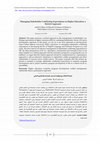
Journal of Educational and Psychological Studies [JEPS]
This paper proposes a hybrid approach to the management of stakeholder conflicting expectations i... more This paper proposes a hybrid approach to the management of stakeholder conflicting expectations in higher education (HE) by combining Stakeholder Theory (ST) and a participatory approach. In this paper, we use an ex post facto approach to retrospectively report Sultan Qaboos University (SQU) experience in managing stakeholder conflicting expectations in developing the BA in English Language and Literature Program as a case study. We show that for an effective management of stakeholder conflicting expectations in HE, the three perspectives of ST (i.e., descriptive, instrumental and normative) have to be taken together as a unified approach with the normative perspective occupying the core. In addition, we argue that this unified approach should be complemented by a participatory approach to add an interactive dimension to stakeholder conflict management and allow stakeholders to become active conflict-solvers. The paper concludes that this hybrid approach is essential to manage stake...

Media, War & Conflict
In this article, the authors apply a narrative model to examine how narratives about the current ... more In this article, the authors apply a narrative model to examine how narratives about the current crisis in Yemen are constructed on English Wikipedia. Using concepts from various narrative theories, as introduced to the field of translation studies by Baker’s Translation and Conflict: A Narrative Account (2006), they analyse an article published on English Wikipedia. The analysis, based on a narrative model designed for this study, focuses on the alleged supporters of the Houthis in the current Yemeni crisis and is applied to the talk pages and history pages associated with the article. The article concludes that, although Wikipedia writers appear free to write and edit without restrictions, they are in fact subject to strict policies and regulations. The transparency of their discussions is a striking feature that controls the quality of the narratives they negotiate on Wikipedia.











Uploads
Papers by Abdul Gabbar Al Sharafi